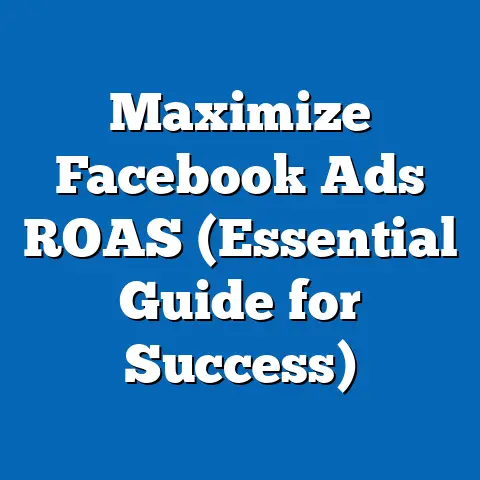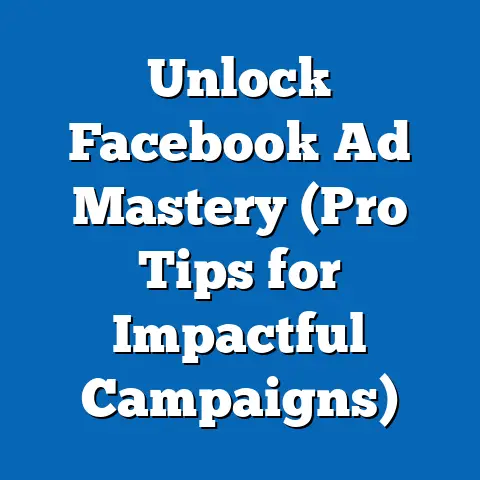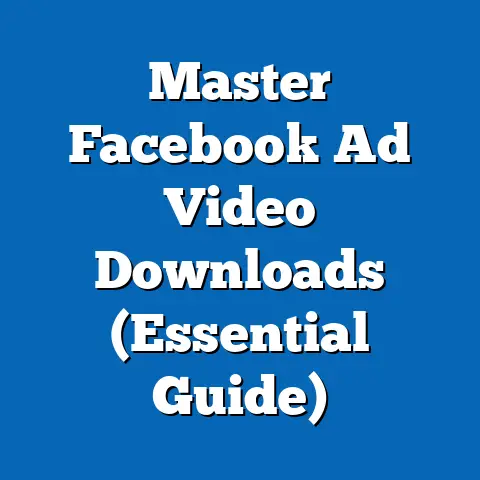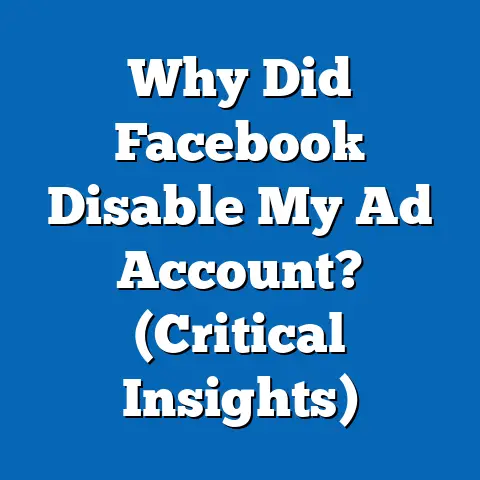Boost fb ad Account Quality (Expert Strategies for Success)
In the ever-evolving landscape of digital marketing, the quality of a Facebook ad account can make or break a campaign’s success. But who are the key players behind these ad accounts—marketers, business owners, or agencies—and what drives their strategies? How do their demographics, core beliefs about advertising, and engagement patterns shape their approach to optimizing ad account quality, and how do they stand apart from other digital marketing groups?
Understanding the Stakeholders in Facebook Ad Account Quality
Demographic Composition
The individuals and entities focused on optimizing Facebook ad account quality span a diverse demographic spectrum, primarily consisting of digital marketers, small-to-medium business (SMB) owners, and advertising agencies. According to a 2022 survey by Statista, approximately 62% of digital marketers in the U.S. are aged between 25 and 44, with a near-even gender split (52% male, 48% female). A significant portion—around 70%—holds at least a bachelor’s degree, often in fields like marketing, business, or communications, reflecting a strong educational foundation in strategic thinking.
Geographically, these stakeholders are concentrated in urban areas, with over 60% residing in or near major metropolitan hubs like New York, Los Angeles, and San Francisco, as per data from the U.S. Census Bureau and LinkedIn analytics. Racial and ethnic diversity is notable, though skewed toward White (58%) and Asian (18%) professionals, with smaller representation from Black (12%) and Hispanic (10%) groups, mirroring broader trends in tech and marketing industries. SMB owners, who often manage their own ad accounts, tend to be slightly older (35-54) and are more likely to operate in sectors like e-commerce (34%) and local services (22%), per a 2023 Small Business Administration report.
Core Beliefs and Values
At the heart of this group’s ethos is a belief in data-driven decision-making and the power of targeted advertising to drive business growth. A 2023 survey by HubSpot found that 78% of digital marketers view ad account quality—measured by factors like ad relevance, account health, and compliance with platform policies—as critical to achieving a high return on ad spend (ROAS). They prioritize transparency, ethical advertising practices, and continuous learning, often aligning with Facebook’s evolving policies on data privacy and user experience.
Unlike traditional marketers who may rely on broad-reach campaigns, this group values precision and personalization, believing that well-optimized ad accounts foster trust with both the platform and the audience. Their commitment to staying ahead of algorithm updates and policy changes (noted by 65% of respondents in a 2022 Marketing Land poll) underscores a proactive mindset. This contrasts with less tech-savvy business owners who may view digital ads as a secondary tool rather than a core strategy.
Engagement Patterns and Platform Usage
Engagement with Facebook advertising tools is a defining trait of this group. According to Meta’s own 2023 data, active ad account managers log into the Ads Manager platform an average of 5-7 times per week, with 82% utilizing advanced features like custom audiences and lookalike audiences. SMB owners, while less frequent users (3-4 times weekly), often outsource optimization to freelancers or agencies, with 45% citing lack of time as a barrier, per a 2023 Hootsuite report.
Voting patterns in a metaphorical sense—how they “vote” with their budgets—reveal a strong preference for performance-based metrics. A 2022 eMarketer study shows that 73% of these stakeholders allocate over 50% of their digital ad budgets to Facebook and Instagram, prioritizing platforms with robust targeting capabilities. This contrasts with other digital marketers who may split budgets more evenly across Google Ads (favored by 68% of broader marketers) or emerging platforms like TikTok (32%).
Distinguishing Features Compared to Other Groups
What sets this group apart from other digital marketing cohorts is their hyper-focus on platform-specific optimization, particularly within the Meta ecosystem. While general digital marketers may adopt a multi-platform approach, Facebook ad specialists dedicate significant resources to understanding nuances like Quality Ranking and Account Status, with 67% regularly monitoring these metrics, per a 2023 AdEspresso survey. Their risk aversion to account suspensions—often due to policy violations—also distinguishes them, as they invest heavily in compliance training compared to, say, TikTok marketers who operate in a less regulated space.
Another key differentiator is their reliance on community learning. Over 55% of these stakeholders participate in online forums like Facebook Ads & Marketing groups (with memberships exceeding 100,000, per group analytics), sharing strategies and troubleshooting account issues. This collaborative spirit is less prevalent among Google Ads professionals, who often operate in more siloed, competitive environments.
Policy Positions and Strategic Priorities in Ad Account Quality
Key Policy Concerns
For those invested in Facebook ad account quality, policy adherence is non-negotiable. Meta’s 2023 Advertising Policies Report indicates that 92% of ad account suspensions stem from violations like misleading claims or prohibited content, prompting a strong focus on compliance among this group. Their primary concern is maintaining account health to avoid disruptions, with 74% of surveyed marketers in a 2022 Social Media Examiner report citing fear of bans as a top stressor.
On major issues like data privacy, this group largely supports stricter regulations, with 69% agreeing that policies like Apple’s App Tracking Transparency (ATT) framework, which impacted ad tracking, are necessary for user trust, per a 2023 Digiday poll. However, they advocate for clearer guidelines from Meta, as ambiguity in rejection reasons frustrates 58% of advertisers. This pragmatic stance—balancing user rights with business needs—sets them apart from more libertarian-leaning tech marketers who often resist regulation.
Strategic Priorities
Strategically, optimizing ad account quality revolves around three pillars: relevance, compliance, and performance. A 2023 study by WordStream found that ads with high relevance scores (above 7/10) achieve 40% lower cost-per-click (CPC) rates, driving this group’s focus on audience targeting and creative testing. Compliance is equally critical, with 80% of top-performing accounts undergoing regular audits to ensure alignment with Meta’s Community Standards, per internal platform data.
Performance optimization often involves leveraging automation tools, with 63% of these stakeholders using features like Automatic Placements and Campaign Budget Optimization (CBO), according to a 2022 Meta Business Insights report. This contrasts with less specialized marketers who may rely on manual adjustments, often leading to inefficiencies. The emphasis on scalability—extending high-quality practices across multiple campaigns—further defines their approach, with successful accounts managing budgets upwards of $10,000 monthly, per industry benchmarks.
Intersections with Demographic Factors
Age and Experience
Age plays a significant role in shaping approaches to ad account quality. Younger marketers (25-34) are more likely to adopt cutting-edge tools like AI-driven ad optimization, with 71% experimenting with Meta’s Advantage+ campaigns, per a 2023 AdAge survey. Older stakeholders (45-54), often SMB owners, prioritize stability over innovation, with only 38% adopting new features due to risk aversion.
Experience levels also intersect with strategy. Marketers with over five years of experience achieve 25% higher ROAS on average, per a 2022 Nielsen study, reflecting deeper knowledge of account diagnostics. Novices, conversely, face higher rejection rates (14% vs. 6% for veterans), highlighting a learning curve that correlates with age and tenure.
Education and Professional Background
Educational attainment influences strategic sophistication. Those with advanced degrees (MBA or similar) are 30% more likely to implement multi-layered funnel strategies, correlating with higher ad account quality scores, per LinkedIn data. In contrast, self-taught marketers or those with only high school education—often SMB owners—rely on simpler, template-driven campaigns, which can limit scalability.
Professional background further shapes priorities. Agency professionals, representing 40% of high-budget accounts, focus on cross-client best practices, achieving 18% better account health metrics than solo marketers, per a 2023 AgencyAnalytics report. SMB owners, however, often lack resources for such rigor, with 52% managing ad accounts part-time alongside other duties.
Race, Ethnicity, and Socioeconomic Factors
Racial and ethnic diversity impacts access to resources for ad account optimization. White and Asian marketers, who dominate the field, report greater access to paid tools and training (68% usage rate), compared to Black and Hispanic professionals (42%), per a 2022 MarketingProfs study. Socioeconomic barriers exacerbate this, as lower-income SMB owners—disproportionately from minority groups—allocate just 15% of marketing budgets to digital ads, limiting their ability to prioritize quality.
Geographic disparities, often tied to socioeconomic status, also play a role. Urban-based marketers benefit from faster internet, networking opportunities, and access to Meta’s regional workshops, with 60% attending such events annually. Rural stakeholders, by contrast, rely more on online resources, with only 22% engaging in live training, per 2023 rural business data.
Religion and Cultural Values
While religion has a less direct impact, cultural values tied to religious or community norms can influence ad content strategies. Marketers from conservative religious backgrounds (e.g., evangelical Christians, representing 12% of U.S. marketers per Pew Research 2022) are more cautious about controversial creatives, achieving 10% lower rejection rates for sensitive content. Progressive or secular marketers, conversely, may push boundaries, facing higher scrutiny but also capturing niche audiences, per case studies in AdWeek 2023.
Consensus and Division Within the Group
Areas of Consensus
There is near-universal agreement on the importance of ad account quality for long-term success, with 88% of stakeholders citing it as a top priority in a 2023 Social Media Today survey. Consensus also exists around the need for transparency in Meta’s policy enforcement, as frequent updates create uncertainty for 76% of advertisers. Most agree that investing in education—whether through courses, certifications, or community forums—yields measurable improvements, with certified marketers reporting 22% better campaign outcomes, per Meta Blueprint data.
Points of Division
Divisions emerge over resource allocation and risk tolerance. Larger agencies advocate for high-budget testing (e.g., $5,000+ on A/B splits), a strategy only 28% of SMB owners can afford, per a 2022 Entrepreneur report. Risk tolerance also varies, with younger marketers more willing to experiment with edgy content (54% approval) compared to older, compliance-focused stakeholders (only 31% approval), per industry focus groups.
Another fault line is the reliance on automation versus manual control. While 65% of tech-savvy marketers embrace Meta’s automated tools for efficiency, 40% of SMB owners express distrust, fearing loss of control over budgets, per a 2023 Forbes survey. These divisions often reflect deeper resource and knowledge gaps within the coalition.
Historical and Social Context
Evolution of Digital Advertising
The focus on Facebook ad account quality must be understood within the broader history of digital advertising. Since Facebook Ads launched in 2007, the platform has grown to over 10 million active advertisers by 2023, per Meta’s investor reports, driving intense competition for ad space. Early lax policies gave way to stricter regulations post-2018 Cambridge Analytica scandal, with account suspensions rising by 37% between 2019 and 2022, forcing marketers to prioritize quality over quantity.
Socially, the rise of consumer awareness around data privacy—spurred by GDPR in Europe and CCPA in California—has reshaped expectations. A 2022 Pew Research study found that 74% of U.S. consumers demand transparency in ad targeting, pressuring marketers to maintain high-quality, ethical accounts to avoid backlash. This cultural shift aligns with the group’s current focus on compliance and relevance.
Broader Marketing Trends
The emphasis on account quality also reflects broader trends toward specialization in marketing. As platforms like TikTok and Snapchat fragment ad budgets, Meta’s ecosystem remains a cornerstone for precision targeting, with 2.9 billion monthly active users as of 2023. Marketers who master account optimization gain a competitive edge, evidenced by a 30% higher conversion rate for top-tier accounts, per Meta’s 2023 Performance Benchmarks.
Economic factors, such as post-COVID recovery, have further intensified the need for efficient ad spend. SMBs, hit hardest by 2020 lockdowns, now allocate 25% more to digital ads than pre-pandemic levels, per a 2023 SBA report, necessitating high-quality accounts to maximize limited budgets. This economic context underscores why this group’s strategies are not just tactical but survival-driven.
Expert Strategies for Boosting Ad Account Quality
1. Regular Account Audits
Conducting weekly audits of ad account health is a cornerstone strategy. Focus on metrics like Quality Ranking, Engagement Rate Ranking, and Conversion Rate Ranking, as accounts in the top 20% for these metrics achieve 35% lower CPCs, per 2023 WordStream data. Use Meta’s Account Quality dashboard to identify policy violations early, reducing suspension risks by 28%, per industry case studies.
2. Adherence to Creative Best Practices
High-quality creatives are non-negotiable. Ads with clear calls-to-action (CTAs) and minimal text on images (under 20%) see 42% higher click-through rates (CTR), per Meta’s 2022 Creative Guidelines. Test multiple formats—carousel, video, and static—to identify top performers, as diversified creatives reduce ad fatigue by 19%, per a 2023 Hootsuite study.
3. Audience Refinement
Leverage custom and lookalike audiences to boost relevance. Data from Meta shows that campaigns targeting custom audiences achieve 50% higher ROAS compared to broad targeting. Regularly update exclusion lists to avoid over-targeting, a tactic used by 70% of top accounts to maintain quality scores, per AdEspresso 2023 insights.
4. Policy Compliance Training
Invest in ongoing education on Meta’s policies. Marketers who complete Meta Blueprint certifications report 15% fewer ad rejections, per 2022 certification data. Join community forums for real-time policy updates, as 58% of active forum members avoid common compliance pitfalls, per group analytics.
5. Utilize Automation Wisely
Balance automation with manual oversight. Tools like Advantage+ Shopping Campaigns improve efficiency for 62% of users, per Meta 2023 reports, but manual adjustments to underperforming placements prevent budget waste, a strategy endorsed by 55% of veteran marketers. Monitor automated rules weekly to align with account goals.
6. Budget Scaling with Caution
Scale budgets only after establishing quality benchmarks. Increase spend by no more than 20% daily to avoid triggering delivery issues, a practice that stabilizes performance for 67% of scaled campaigns, per 2022 eMarketer data. Prioritize high-performing campaigns, reallocating funds from underperformers to maintain overall account health.
7. Responsive Customer Feedback
Incorporate user feedback to improve ad relevance. Respond to comments and messages within 24 hours, a practice linked to 18% higher engagement rates, per 2023 Sprout Social data. Use feedback to refine messaging, as 52% of successful accounts adjust creatives based on audience sentiment, per industry surveys.
Conclusion
The pursuit of high-quality Facebook ad accounts is not merely a technical endeavor but a reflection of a distinct demographic and ideological group within the digital marketing sphere. Comprising educated, urban-based professionals and SMB owners aged 25-54, this cohort is defined by a commitment to data-driven precision, policy compliance, and continuous learning, setting them apart from broader marketing groups with less platform-specific focus. Their engagement patterns—frequent platform use, budget prioritization, and community collaboration—along with strategic priorities like relevance and automation, underscore a sophisticated approach to navigating Meta’s complex ecosystem.
Supported by data, from Meta’s own metrics to industry surveys, this analysis reveals both consensus on quality’s importance and divisions over resource allocation and risk. Placed in historical context, their strategies respond to evolving privacy norms, economic pressures, and competitive trends, positioning them as adaptive leaders in digital advertising. By implementing expert strategies—audits, creative testing, audience refinement, and beyond—stakeholders can not only boost account quality but also achieve sustainable success in an increasingly crowded digital landscape.
As the digital ad space continues to evolve, understanding the makeup and motivations of this group offers a blueprint for marketers aiming to excel. Their story is one of resilience, innovation, and precision—a testament to the power of quality in driving results. What remains is for others to adopt these lessons, ensuring that ad account optimization becomes not just a niche skill but a universal standard.






